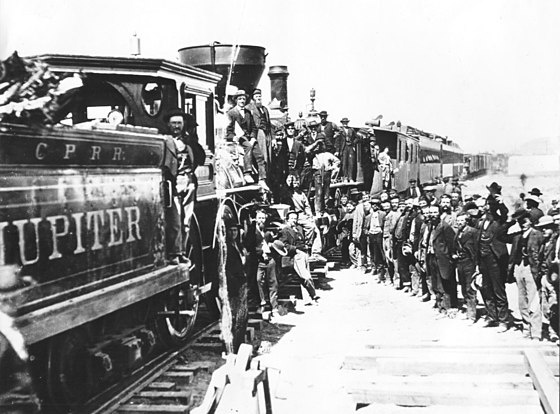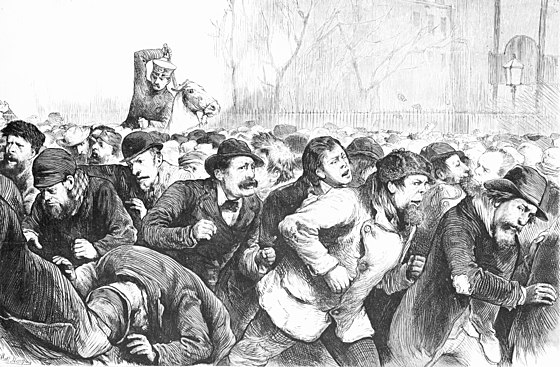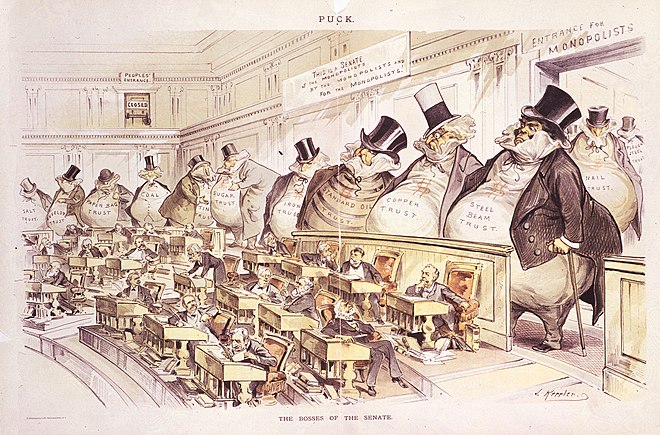Ashley Rossi
Eshal Warsi
AP US History 🇺🇸
454 resourcesSee Units
The Gilded Age was a period of great change in the United States, as the country transformed from an agrarian society to an industrial one.
Explain the extent to which industrialization brought change from 1865 to 1898.
Technology and Capitalism
Large-scale industrial production became the norm, with factories producing goods on a massive scale using new technologies and techniques such as the assembly line. This allowed for the mass production of goods at a lower cost, making them more affordable for a wider range of people. Industries such as steel, oil, and railroads grew and prospered during this period,
Industrial growth also led to the rise of big businesses and monopolies, controlled by a small group of wealthy and powerful individuals, known as "Robber Barons" . This period also saw the rise of new forms of labor, such as the growth of the labor movement and the rise of the working class.

Image Courtesy of Wikipedia
Labor Movements
During the Gilded Age, labor movements in the United States began to form and organize as a response to the poor working conditions and low wages in the rapidly growing industrial sector. These movements sought to improve the rights and conditions of workers through collective action and bargaining.
One of the first major labor movements was the National Labor Union, formed in 1866, which aimed to improve wages, reduce working hours, and promote the rights of workers across industries.
Another important labor movement was the Knights of Labor, formed in 1869, which sought to unite all workers, regardless of skill or occupation, and improve their rights and conditions.

Image Courtesy of Wikipedia
In 1881, the American Federation of Labor (AFL) was formed, which focused on organizing skilled workers and negotiating with employers for better wages, hours, and working conditions.
These movements faced significant opposition from industrialists and the government, and often faced violent repression. Many strikes and protests were met with force, and leaders of these movements were often arrested and persecuted.
Despite these obstacles, labor movements during the Gilded Age were able to achieve some successes, such as the eight-hour workday and the reduction of working hours, but they were not able to fully achieve their goals of improving working conditions and wages.
Farmers Movements
During the Gilded Age, farmers in the United States faced a number of challenges, including low prices for their crops, high transportation costs, and a lack of access to credit. In response to these challenges, farmers formed a number of organizations and movements to advocate for their rights and interests.
One of the most significant farmer movements during this period was the Grange Movement. Founded in 1867, the Grange aimed to improve the economic and social conditions of farmers through education, cooperative efforts, and political action. The organization also sought to improve transportation and marketing for farmers' products, and to provide mutual aid and support for its members.
Another important farmer movement was the Populist Party, also known as the People's Party. Founded in 1891, the Populist Party sought to represent the interests of farmers, laborers, and other marginalized groups in American society. The party advocated for policies such as free coinage of silver, the establishment of a graduated income tax, and the nationalization of railroads.
Both of these movements were not able to fully achieve their goals, but they were able to bring attention to the struggles of farmers during the Gilded Age and raise awareness of the issues they were facing.
Migration
Migrations (both national and international) during this period massively changed the nation in both urban and rural areas. One of the most significant was the movement of people from rural areas to urban centers, as the country transformed from an agrarian society to an industrial one. Many people moved to cities in search of jobs in the rapidly growing industrial sector. This led to the rapid expansion of urban areas and the growth of large, industrial cities such as New York, Chicago, and Pittsburgh.
Another significant migration during this period was the movement of African Americans from the South to the North, known as the Great Migration. Beginning in the late 19th century and continuing into the 20th century, many African Americans left the South due to a combination of economic, social, and political factors, such as the decline of the agricultural economy, racial violence, and limited opportunities for advancement. They moved to Northern cities in search of better economic opportunities and to escape the discriminatory laws and practices of the South.

Image Courtesy of Wikipedia
There were also migrations of immigrants from Europe and Asia to the United States during the Gilded Age. Many came from Ireland, Germany, and Italy. These immigrants were attracted to the economic opportunities in the United States and to escape poverty and political unrest in their home countries
Migration westward in the United States led to a number of conflicts. One of the most significant conflicts was the displacement of Native American tribes from their ancestral lands. As settlers moved westward, they often took over land that had been traditionally occupied by Native American tribes. The US government, through a policy of forced relocation, treaties, and military campaigns, removed many Native American tribes from their lands and forced them to move to reservations.
Additionally, the migration westward also led to conflicts with other ethnic groups such as the Chinese immigrants, who were brought to work on the transcontinental railroad, but faced discrimination and violence once the work was done.
Urban Culture
In the rapidly growing cities of the time, there was a cultural divide between the wealthy elite and the working class. The wealthy elite lived in opulent homes and enjoyed a lavish lifestyle, while the working class lived in overcrowded and poor conditions. The wealthy elite frequented exclusive clubs, restaurants, and theaters, and were involved in a wide range of cultural activities such as art, literature, and music.
On the other hand, the working class had limited access to these cultural activities. They had to make do with the few recreational opportunities available to them, such as saloons, cheap theaters, and vaudeville shows. The working class also developed its own forms of culture, such as the rise of the labor movement and the creation of ethnic and immigrant communities.
Despite the divide, the Gilded Age saw the emergence of some of the first mass consumer cultures in the United States, with the rise of department stores, mail-order catalogs, and national advertising. The growth of the consumer culture led to the rise of new forms of leisure and entertainment, such as amusement parks, baseball, and vaudeville shows.
Gilded Age Movements
One of the most significant cultural movements of the time was the "Gilded Age" literary movement, which was characterized by a focus on realist and naturalist writing, and often dealt with themes of corruption, materialism, and social injustice. Notable writers of this movement include Mark Twain, Henry James, and Edith Wharton.
Another cultural movement of the time was the "Aesthetic movement" also known as "art for art's sake" movement. It emerged as a reaction to the materialism and commercialism of the Gilded Age, and advocated for the pursuit of beauty and art for its own sake, rather than for practical or commercial purposes.
In the intellectual sphere, the Gilded Age saw the emergence of the "Darwinian evolution" theory and "Social Darwinism" which attempted to apply the principles of natural selection to social and economic issues. This led to the rise of the "Eugenics" movement, which aimed to improve the human race through selective breeding and sterilization.
Corruption
The Credit Mobilier scandal was a political scandal that involved Credit Mobilier of America, a construction company created by the Union Pacific Railroad to build the transcontinental railroad. The company was found to have bribed members of Congress, including Vice President Schuyler Colfax and Speaker of the House James G. Blaine, with stock in the company in order to secure favorable legislation and contracts.

Image Courtesy of Wikipedia
Political machines, such as Tammany Hall in New York City, controlled many city and state governments and were known for their corrupt practices, including bribery and voter fraud. Many big businesses, such as the railroads, also engaged in corrupt practices, such as bribing politicians to gain favorable legislation and contracts. Additionally, the lack of effective regulation allowed for widespread fraud and corruption in the financial sector, leading to several major financial crises.
The Panic of 1893, was one of the worst financial crises in American history, caused by a number of factors including over-speculation in railroads and a deflation of the silver market.
The Gilded Age was a stark departure from the agrarian nation Thomas Jefferson envisioned.
🎥 Watch: AP US History - Gilded Age Review
Browse Study Guides By Unit
🌽Unit 1 – Interactions North America, 1491-1607
🦃Unit 2 – Colonial Society, 1607-1754
🔫Unit 3 – Conflict & American Independence, 1754-1800
🐎Unit 4 – American Expansion, 1800-1848
💣Unit 5 – Civil War & Reconstruction, 1848-1877
🚂Unit 6 – Industrialization & the Gilded Age, 1865-1898
🌎Unit 7 – Conflict in the Early 20th Century, 1890-1945
🥶Unit 8 – The Postwar Period & Cold War, 1945-1980
📲Unit 9 – Entering Into the 21st Century, 1980-Present
📚Study Tools
🤔Exam Skills
👉🏼Subject Guides
📚AMSCO Notes

Fiveable
Resources
© 2025 Fiveable Inc. All rights reserved.